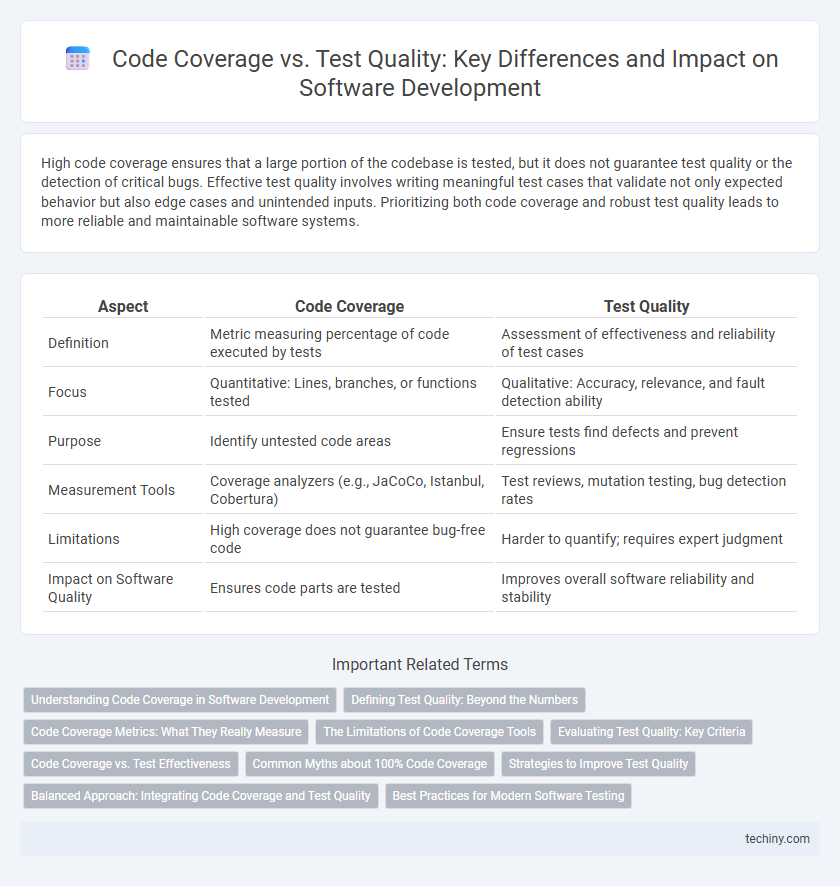High code coverage ensures that a large portion of the codebase is tested, but it does not guarantee test quality or the detection of critical bugs. Effective test quality involves writing meaningful test cases that validate not only expected behavior but also edge cases and unintended inputs. Prioritizing both code coverage and robust test quality leads to more reliable and maintainable software systems.
Table of Comparison
| Aspect | Code Coverage | Test Quality |
|---|---|---|
| Definition | Metric measuring percentage of code executed by tests | Assessment of effectiveness and reliability of test cases |
| Focus | Quantitative: Lines, branches, or functions tested | Qualitative: Accuracy, relevance, and fault detection ability |
| Purpose | Identify untested code areas | Ensure tests find defects and prevent regressions |
| Measurement Tools | Coverage analyzers (e.g., JaCoCo, Istanbul, Cobertura) | Test reviews, mutation testing, bug detection rates |
| Limitations | High coverage does not guarantee bug-free code | Harder to quantify; requires expert judgment |
| Impact on Software Quality | Ensures code parts are tested | Improves overall software reliability and stability |
Understanding Code Coverage in Software Development
Code coverage measures the percentage of source code executed during testing, providing insight into which parts of the software are tested. High code coverage does not guarantee high test quality but helps identify untested areas that may hide defects. Understanding code coverage metrics like line, branch, and function coverage is crucial for developers to optimize testing efforts and improve software reliability.
Defining Test Quality: Beyond the Numbers
Test quality in software development measures how effectively tests identify defects and ensure application reliability, transcending mere code coverage percentages. High-quality tests evaluate edge cases, validate business logic, and maintain readability and maintainability, contributing to sustainable development workflows. Emphasizing test quality drives improved software robustness and user satisfaction beyond achieving arbitrary code coverage metrics.
Code Coverage Metrics: What They Really Measure
Code coverage metrics quantify the percentage of source code executed during testing but do not directly measure test quality or effectiveness. These metrics primarily identify untested code areas, helping developers target gaps but cannot assess the thoroughness or correctness of test cases. High code coverage alone may give a false sense of security if tests lack meaningful assertions or fail to cover edge cases and logic errors.
The Limitations of Code Coverage Tools
Code coverage tools measure the percentage of code executed by tests but do not assess the effectiveness or depth of those tests in detecting defects. These tools often miss gaps in test quality such as inadequate assertions, poor input variety, or untested edge cases. Relying solely on code coverage metrics can create a false sense of security, overlooking critical issues that comprehensive test design and quality analysis would reveal.
Evaluating Test Quality: Key Criteria
Evaluating test quality requires analyzing code coverage metrics alongside defect detection effectiveness, test case relevance, and maintenance simplicity. High-quality tests not only cover a large percentage of code but also identify critical bugs and validate real-world scenarios. Test suites with comprehensive assertions, minimal redundancy, and clear documentation significantly enhance overall software reliability.
Code Coverage vs. Test Effectiveness
High code coverage alone does not guarantee test effectiveness, as it measures the quantity of code executed but not the quality of tests or their ability to catch defects. Test effectiveness depends on the design of test cases, including boundary value analysis, equivalence partitioning, and fault injection, which better evaluate software behavior under varied conditions. Combining thorough code coverage metrics with well-engineered test scenarios ensures a more reliable assessment of the software's robustness and bug detection capability.
Common Myths about 100% Code Coverage
Achieving 100% code coverage does not guarantee high test quality, as coverage metrics only measure the extent of code executed during testing, not the effectiveness of the tests in catching defects. Common myths include the belief that full coverage ensures bug-free software or that more coverage automatically means better tests, ignoring the significance of test case design and edge case validation. Effective testing combines adequate code coverage with comprehensive test scenarios that verify both expected and unexpected behaviors to improve software reliability.
Strategies to Improve Test Quality
Improving test quality requires focusing on meaningful test cases that validate functional requirements rather than merely increasing code coverage percentages. Employing mutation testing and behavior-driven development (BDD) can uncover gaps in test suites and enhance test scenario relevance. Integrating continuous feedback from code reviews and automated test results ensures tests remain robust and aligned with software behavior.
Balanced Approach: Integrating Code Coverage and Test Quality
Achieving a balanced approach in software development requires integrating code coverage metrics with test quality assessments to ensure comprehensive and effective testing. High code coverage alone does not guarantee robust tests; incorporating test quality factors like test case relevance, edge case handling, and defect detection rates enhances overall software reliability. Combining quantitative coverage data with qualitative evaluations supports the creation of maintainable, resilient applications and reduces the risk of undetected bugs in production.
Best Practices for Modern Software Testing
High code coverage alone does not guarantee test quality; effective testing prioritizes meaningful, well-designed test cases that validate critical functionalities and edge cases. Employing practices such as behavior-driven development (BDD) and continuous integration (CI) ensures tests are relevant, maintainable, and reflective of real-world scenarios. Leveraging code coverage metrics alongside mutation testing helps identify untested code paths and strengthens overall software reliability.
Code Coverage vs Test Quality Infographic

 techiny.com
techiny.com